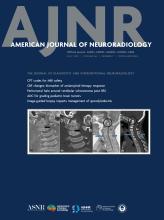Case of the Week
Section Editors: Matylda Machnowska1 and Anvita Pauranik2
1University of Toronto, Toronto, Ontario, Canada
2BC Children's Hospital, University of British Columbia, Vancouver, British Columbia, Canada
Sign up to receive an email alert when a new Case of the Week is posted.
October 14, 2021
Papillary Glioneuronal Tumor
- Background:
- Papillary glioneuronal tumors (PGNTs) are rare mixed glial and neuronal tumors only recently described by the World Health Organization (WHO) in 2007 and assigned grade I in the 2016 WHO classification.
- Histopathologically, they are characterized by hyalinized vascular pseudopapillae comprising NeuN-positive neuronal cells lined by GFAP-positive small cuboidal glial cells.
- Few aggressive variants have been reported, typically related to mitotic activity.
- Clinical Presentation:
- Presentation with increasing headaches with or without seizures, with a smaller subset presenting with focal neurologic deficits including visual disturbances, ataxia, and hemiparesis
- PGNTs usually occur in children and young adults. The age range is 4–75 years; the median age at diagnosis is 23 years, with 60% being diagnosed by the age of 26.
- Key Diagnostic Features:
- PGNTs are well-defined, supratentorial tumors, with most occurring in the frontal or temporal lobes. They are not necessarily cortically based in location and, in fact, prefer the deep white matter.
- Most are cystic with a mural nodule/solid component. The solid component invariably demonstrates robust enhancement of various patterns (ring, homogeneous, or heterogeneous). Purely solid tumors have been reported in <10%, as in the second case.
- Calcification is not uncommon; intratumoral hemorrhage, perilesional edema, and mass effect are rare.
- Restricted diffusion is not a typical feature.
- Differential Diagnoses:
-
Ganglioglioma: Also a cystic mass with avidly enhancing mural nodule, calcification, and temporal lobe predilection in a young demographic, but cortically based
-
Gangliocytoma: Similar features to ganglioglioma
-
Pleomorphic xanthoastrocytoma: Also a cystic mass with mural nodule and temporal lobe predilection in a young demographic, but cortically based
-
DNET: “Bubbly” mass also in a young demographic with frontotemporal lobe predilection, no mass effect, and no edema, but cortically based and minimal enhancement
-
Pilocytic astrocytoma: Also a cystic mass with avidly enhancing mural nodule in a young demographic, but more frequently infratentorial
-
Metastasis: 50% are solitary, although perilesional edema is present and striking.
-
Nonneoplastic cystic lesions: Resolving hematoma, neurocysticercosis, enlarged perivascular space
-
-
Treatment:
-
As WHO grade I tumors, most undergo total gross resection without need for additional therapy.
-
In rare cases of anaplastic PGNTs or those with aggressive imaging features, chemoradiation with temozolomide (as similarly used in the Stupp protocol for glioblastoma) is used in the postoperative setting.
-











